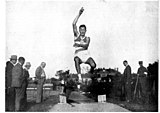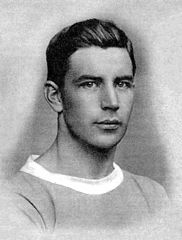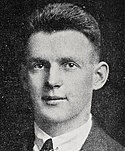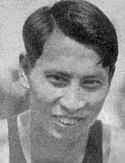Olympische Sommerspiele 1928/Leichtathletik – Dreisprung (Männer)
 | |||||||||
| Sportart | Leichtathletik | ||||||||
| Disziplin | Dreisprung | ||||||||
| Geschlecht | Männer | ||||||||
| Teilnehmer | 24 Athleten aus 14 Ländern | ||||||||
| Wettkampfort | Olympiastadion Amsterdam | ||||||||
| Wettkampfphase | 2. August 1928 | ||||||||
| |||||||||
Der Dreisprung der Männer bei den Olympischen Spielen 1928 in Amsterdam wurde am 2. August 1928 im Olympiastadion Amsterdam ausgetragen. 24 Athleten nahmen teil.
Olympiasieger wurde der Japaner Oda Mikio vor dem US-Amerikaner Levi Casey. Bronze ging an Vilho Tuulos aus Finnland.
Bestehende Rekorde
| Weltrekord[1] | 15,52 m | Dan Ahearn ( | New York, USA | 30. Mai 1911 |
| Nick Winter ( | Finale OS Paris, Frankreich | 12. Juli 1924 | ||
| Olympischer Rekord | Nick Winter ( | Finale OS Paris, Frankreich | 12. Juli 1924 |
Der Olympia- und Weltrekord wurde bei diesen Spielen nicht erreicht.
Durchführung des Wettbewerbs
Am 2. August gab es eine Qualifikationsrunde in zwei Gruppen. Für das Finale, das am selben Tag stattfand, qualifizierten sich die sechs besten Springer – hellblau unterlegt – aus den beiden Gruppen. Dabei ging das Resultat der Qualifikation mit in das Endresultat ein.[2]
Qualifikation
Datum: 2. August 1928
Gruppe 1
Nick Winter – Olympiasieger 1924 – ausgeschieden mit 14,15 m in Qualifikationsgruppe 1
Steef van Musscher – ausgeschieden mit 13,93 m in Qualifikationsgruppe 1
Wilfrid Kalaugher – ausgeschieden mit 12,94 m in Qualifikationsgruppe 1
| Platz | Name | Nation | Weite |
|---|---|---|---|
| 1 | Oda Mikio | 15,21 m | |
| 2 | Vilho Tuulos | 14,73 m | |
| 3 | Toimi Tulikoura | 14,70 m | |
| 4 | Willem Peters | 14,55 m | |
| 5 | Sidney Bowman | 14,35 m | |
| 6 | Nick Winter | 14,15 m | |
| 7 | Steef van Musscher | 13,93 m | |
| 8 | Konstantinos Petridis | 13,83 m | |
| 9 | Theo Phelan | 13,73 m | |
| 10 | Bob Kelley | 13,64 m | |
| 11 | Arild Lenth | 13,39 m | |
| 12 | Ferenc Molnár | 13,36 m | |
| 13 | Wilfrid Kalaugher | 12,94 m |
Gruppe 2
Imre Fekete – ausgeschieden mit 14,07 m in Qualifikationsgruppe 2
Johannes Viljoen – ausgeschieden mit 12,49 m in Qualifikationsgruppe 2
| Platz | Name | Nation | Weite |
|---|---|---|---|
| 1 | Nambu Chūhei | 15,01 m | |
| 2 | Levi Casey | 14,93 m | |
| 3 | Erkki Järvinen | 14,65 m | |
| 4 | Väinö Rainio | 14,41 m | |
| 5 | Jan Blankers | 14,35 m | |
| 6 | Lloyd Bourgeois | 14,28 m | |
| 7 | Gijs Lamoree | 14,08 m | |
| 8 | Imre Fekete | 14,07 m | |
| 9 | Alex Munroe | 13,87 m | |
| 10 | Hermann Brügmann | 13,82 m | |
| 11 | Johannes Viljoen | 12,49 m |
Finale und Resultat der besten Acht

Datum: 2. August 1928
| Finale | ||||||||
| Platz | Name | Nation | Qualifikationsweite | 1. Versuch | 2. Versuch | 3. Versuch | Endresultat | |
| 1 | Oda Mikio | 15,21 m | 15,21 m | x | 15,21 m | 15,21 m | ||
| 2 | Levi Casey | 14,93 m | 14,93 m | 15,17 m | 15,17 m | 15,17 m | ||
| 3 | Vilho Tuulos | 15,09 m | 15,09 m | 15,11 m | 15,11 m | 15,11 m | ||
| 4 | Nambu Chūhei | 15,01 m | 15,01 m | 15,00 m | 15,01 m | 15,01 m | ||
| 5 | Toimi Tulikoura | 14,70 m | 14,70 m | 14,62 m | 14,70 m | 14,70 m | ||
| 6 | Erkki Järvinen | 14,65 m | 14,65 m | x | 14,65 m | 14,65 m | ||
| 7 | Willem Peters | 14,55 m | nicht für das Finale qualifiziert | 14,55 m | ||||
| 8 | Väinö Rainio | 14,41 m | 14,41 m | |||||
In Amsterdam begründete Oda Mikio die japanische Dominanz im Dreisprung für drei Olympische Spiele. Er siegte mit 15,21 m knapp vor dem US-Amerikaner Levi Casey, der 15,17 m sprang. Mit 15,11 m errang der inzwischen 33-jährige Olympiasieger von 1920 Vilho Tuulos die Bronzemedaille. Nick Winter, Olympiasieger von 1924 nahm zwar ebenfalls an diesem Wettkampf teil, hatte aber nicht mehr die Form von 1924 und landete auf dem zwölften Platz.
Oda Mikio errang den ersten japanischen Olympiasieg und zugleich die erste japanische Medaille im Dreisprung.
Bronze gab es dismal für Vilho Tuulos, unter anderem Olympiasieger von 1920
Platz vier für Nambu Chūhei, der 1932 Gold gewinnen sollte
Video
- Oda Becomes Asia's First Individual Olympic Champion - Amsterdam 1928 Olympics, veröffentlicht am 9. Oktober 2012 auf youtube.com, abgerufen am 14. September 2017
Literatur
- Ekkehard zur Megede, Die Geschichte der olympischen Leichtathletik, Band 1: 1896–1936, Verlag Bartels & Wernitz KG, Berlin, 2. Auflage 1970, S. 205
Weblinks
- Amsterdam 1928 Athletics, triple jump men, Seite des IOC, olympics.com, abgerufen am 21. Juni 2021
- Athletics at the 1928 Amsterdam Summer Games: Men's Triple Jump, web.archive.org, sports-reference.com, abgerufen am 13. September 2017
- The Ninth Olympiad Amsterdam 1928, official report, S. 446 bis 448, library.olympic.org, englisch (PDF; 137.840 KB), abgerufen am 21. Juni 2021
- Olympedia, 1928 Summer Olympics, Athletics Triple Jump, Men, olympedia.org (englisch), abgerufen am 21. Juni 2021
Einzelnachweise
- ↑ Weltrekorde. Dreisprung Männer, rekorde-im-sport.de, abgerufen am 21. Juni 2021
- ↑ The Ninth Olympiad Amsterdam 1928, official report, S. 446 bis 448, library.olympic.org, englisch (PDF; 137.840 KB), abgerufen am 21. Juni 2021
Auf dieser Seite verwendete Medien
Olympic Rings without "rims" (gaps between the rings), As used, eg. in the logos of the 2008 and 2016 Olympics. The colour scheme applied here was specified in 2023 guidelines.
Olympic Rings without "rims" (gaps between the rings), As used, eg. in the logos of the 2008 and 2016 Olympics. The colour scheme applied here was specified in 2023 guidelines.
Autor/Urheber: B1mbo, Lizenz: CC BY-SA 2.5
Zeichnung einer Goldmedaille, basierend auf Olympic rings.svg.
Variant version of a flag of Japan, used between January 27, 1870 and August 13, 1999 (aspect ratio 7:10).
Variant version of a flag of Japan, used between January 27, 1870 and August 13, 1999 (aspect ratio 7:10).
Autor/Urheber: B1mbo, Lizenz: CC BY-SA 2.5
Zeichnung einer Silbermedaille, basierend auf Olympic rings.svg.
US Flag with 48 stars. In use for 47 years from July 4, 1912, to July 3, 1959.
Autor/Urheber: B1mbo, Lizenz: CC BY-SA 2.5
Zeichnung einer Bronzemedaille, basierend auf Olympic rings.svg.
Flag of Australia, when congruence with this colour chart is required (i.e. when a "less bright" version is needed).
See Flag of Australia.svg for main file information.Man sagt, dass der grüne Teil die Mehrheit der katholischen Einwohner des Landes repräsentiert, der orange Teil die Minderheit der protestantischen, und die weiße Mitte den Frieden und die Harmonie zwischen beiden.
Flag of South Africa, used between 1928 and 1982. It is identical to the 1982 to 1994 version except that the shade of blue is darker. It is also known as the "Oranje-Blanje-Blou".
Flag of South Africa, used between 1928 and 1982. It is identical to the 1982 to 1994 version except that the shade of blue is darker. It is also known as the "Oranje-Blanje-Blou".
Flag of Hungary from 6 November 1915 to 29 November 1918 and from August 1919 until mid/late 1946.
an athlete from Japan,南部忠平(Chuhei Nanbu)
Olympic Stadium, Amsterdam.
Olympische Spelen 1928 Amsterdam, Nederland : Finish van de achtste serie van de 100 meter hardlopen. De Zuidafrikaan Viljoen.
Autor/Urheber: Dorogifc, Lizenz: CC BY-SA 3.0
Imre Fekete was a great atletic from Dorog who has been in Olympic Game in Amsterdam in 1928
Vilho Tuulos
The Canadian Red Ensign used between 1921 and 1957.
This image has compared for accuracy (mainly colors) using an image from World Statesmen. The only change is making the maple leaves green from red. This image has compared for accuracy (mainly colors) using an image from World Statesmen. The most recent version of this image has changed the harp into one with a female figure; see [http://flagspot.net/flags/ca-1921.html FOTW
Wilfrid George Kalaugher (1904–1999), New Zealand athlete and later schoolmaster and first-class cricketer in the United Kingdom
Part of collection: Jeux Olympiques de 1924.; Official postcrd no. 424.; Also available in an electronic version via the Internet at: nla.gov.au/nla.pic-vn3098002. Anthony 'Nick' Winter won a gold medal in the triple jump, setting a world record in the process.
Persistent URL
nla.gov.au/nla.pic-vn3098002Sport, Olympische Spelen Amsterdam, 1928 : De Nederlandse athleet S. van Musscher in actie tijdens de hink-stap-sprong.































